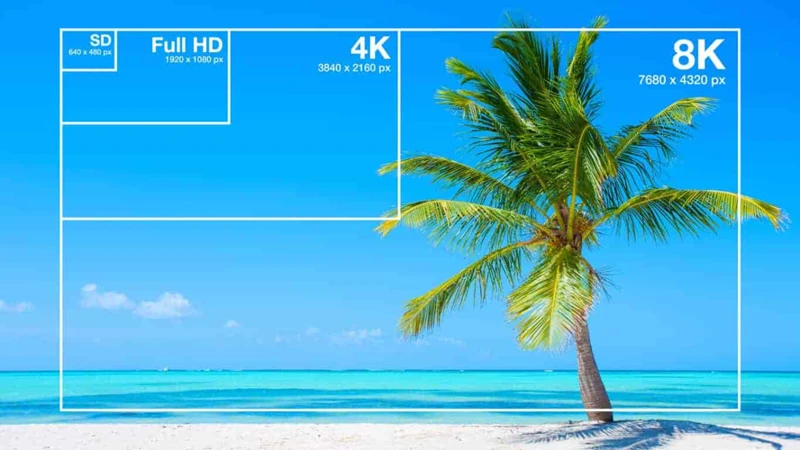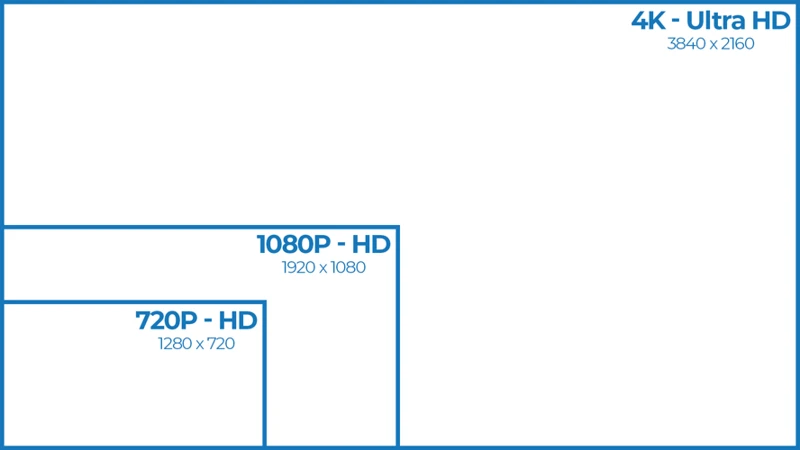As we step into the age of advanced technology, video surveillance has become an essential aspect for ensuring safety and security in both residential and commercial settings. However, before investing in a surveillance system, it’s crucial to have a good understanding of different resolution options available in the market. Surprisingly, choosing the right video surveillance resolution isn’t as straightforward as it seems. With a multitude of options, it can be perplexing to select the most appropriate one that meets your security needs. In this article, we’ll delve deeper into resolution basics and the types of video surveillance resolutions available, and help you choose the right one for your specific needs.
Resolution Basics: What You Need to Know

Understanding the difference between the various resolution options in video surveillance can be overwhelming for the uninitiated. However, having a basic grasp of the Resolution Basics is crucial when it comes to choosing the right surveillance camera for your needs. In this section of the article, we’ll delve into what video resolution is and why it matters, as well as explore the various types of resolutions available on the market today. This will give you a solid foundation upon which to build your knowledge of video surveillance technology. So, before we move forward to explore the different resolution options available in video surveillance, let’s first understand the basics.
What is Video Resolution?
Video resolution refers to the number of pixels in a video image, both horizontally and vertically. The resolution of a video determines how detailed the image will appear. A higher resolution means a more detailed image and a lower resolution means a less-detailed image. The higher the resolution, the more bandwidth and storage space required to store the video footage.
Here is a table showing the common resolutions used in video surveillance and their corresponding pixel dimensions:
| Resolution | Pixel Dimensions (width x height) |
|---|---|
| Standard Definition (SD) | 720 x 480 |
| High Definition (HD) | 1280 x 720 |
| Full HD (FHD) | 1920 x 1080 |
| 4K Ultra HD | 3840 x 2160 |
| Megapixel | Varying pixel dimensions, typically higher than FHD |
| Multi-Sensor | Varying pixel dimensions, typically higher than FHD |
It’s important to note that the resolution is just one factor in determining the overall quality of a video image. Other factors, such as the camera lens, lighting conditions, and compression settings can also impact the quality of the footage.
Understanding video resolution is crucial when choosing a surveillance camera. By selecting the right resolution, you can ensure that you capture the level of detail you need for your security purposes while balancing the storage and bandwidth requirements of your setup. For more information on the impact of video resolution on storage and bandwidth, check out our other article on maximizing value with video surveillance resolution. Additionally, for a look into the future of video surveillance resolution technology, read our article on future trends in video surveillance resolution tech.
Why Does Resolution Matter?
Resolution matters because it affects the quality of the video that the surveillance camera captures. Video surveillance resolution refers to the number of pixels the camera can capture and display in an image. The higher the resolution, the clearer and more detailed the image will be. This means that with high-resolution cameras, you will be able to see greater detail in the video footage, making it easier to identify people, objects, or incidents.
However, higher resolution cameras may not be ideal for every surveillance application. For example, if you want to monitor large areas such as parking lots or warehouses, and you want to capture multiple angles from different cameras, it may not be cost-effective to use high-resolution cameras for all of them. In this case, you may want to consider a mix of lower and higher resolution cameras to maximize coverage while minimizing costs.
On the other hand, if you need to capture fine details for forensic purposes, higher resolution cameras may be necessary. For example, if you need to monitor a jewelry store, museum, or casino, where details like facial features, intricate designs or small details are important to capture, high-resolution cameras will be necessary to get the job done effectively.
Another factor to consider when choosing the right video surveillance resolution is storage capacity. Higher resolution cameras will produce larger files and require more powerful hardware and storage with higher capacity. This means that you’ll need to assess your storage needs and budget accordingly.
| Advantages of High Resolution Cameras | Disadvantages of High Resolution Cameras |
|---|---|
| Ability to capture finer details | Require more storage and processing power |
| Better identification of people and objects in the footage | Higher resolution cameras cost more |
| Ability to zoom in and digitally enhance the footage | Not ideal for monitoring large areas or multiple angles |
| Higher-quality evidence for forensic purposes |
When choosing the right video surveillance resolution, you need to consider your security needs, assess your environment, determine your budget, and understand your equipment capabilities. While it may be tempting to invest in high-resolution cameras, it’s important to evaluate your needs and balance them against the costs of the hardware, storage, and processing power. Knowing the advantages and disadvantages of high-resolution cameras can help you make an informed decision, balancing the benefits against the costs.
Types of Video Surveillance Resolutions

When it comes to video surveillance, choosing the right resolution is crucial. Different resolution options are available and each offers unique benefits. Understanding these differences is essential for selecting the ideal resolution for your specific needs. In this section, we’ll take a closer look at the different types of video surveillance resolutions so you can make an informed decision. Whether you’re interested in high-res cameras in surveillance or want to learn more about maximizing value in video surveillance resolution, this section will help you choose the best option for your purposes.
Standard Definition (SD)
When it comes to understanding video surveillance resolution, Standard Definition (SD) is the lowest resolution option available. This option is commonly used in older CCTV technologies and has resolution limits of 720 x 480 pixels. To put this in perspective, SD resolution is the same as the quality you would expect from a DVD.
SD cameras offer several benefits, such as requiring less bandwidth and storage space. They are also typically more affordable than higher resolution options. However, the lower resolution comes at a cost. The image quality is poor, and the footage may not be usable in recognizing individuals’ facial features or license plate numbers, for example.
It’s worth noting that standard definition can still play a role in video surveillance, depending on the user’s needs. For example, if the cameras are used solely as a deterrent rather than evidence, SD resolution may be sufficient. It’s also essential to consider the camera’s field of view and placement to maximize the benefits of SD cameras.
In general, it’s recommended to upgrade from SD resolution to higher resolution options to achieve better surveillance results. However, SD cameras can still be a viable option in specific situations or for those on a budget.
If you want to learn more about higher resolution options or maximizing value in video surveillance resolution, check out our related articles on high-res cameras in surveillance and maximizing value in video surveillance resolution.
High Definition (HD)
When it comes to video surveillance, High Definition (HD) resolution has become a popular option. HD refers to cameras that have a resolution of at least 720p, which means that the image captured has 720 horizontal lines of pixels. They offer a step up from Standard Definition (SD) cameras, providing clearer and more detailed images.
The benefits of HD resolution:
- Clarity: HD cameras capture sharper and clearer images, thanks to their higher pixel count. This can be essential for identifying small details, such as facial features, license plates, or even clothing details.
- Flexibility: HD cameras can be used in a wide range of environments and situations, from indoor spaces to outdoor areas, and in low light or high light situations.
- Zooming: HD cameras allow for digital zooming without losing too much image quality, giving the user the ability to zoom in on specific details while still maintaining a clear and sharp image.
- Cost-effective: While HD cameras do tend to be slightly more expensive than SD cameras, they offer a cost-effective solution for those who want clearer and more detailed images without investing in the highest resolution cameras on the market.
HD cameras are a great solution for security needs in a variety of settings. However, it’s important to consider your specific needs and environment before investing in any video surveillance equipment.
Full HD (FHD)
When it comes to video surveillance, Full HD (FHD) is one of the most popular resolutions, known for its high-quality images and clear video footage. FHD has a resolution of 1920 x 1080, which means it displays 1920 pixels horizontally and 1080 vertically. This results in a total of over two million pixels, producing an incredibly detailed image that captures even the smallest details.
Advantages of Full HD
FHD is a significant step up from standard definition (SD) and offers many advantages to those who use it. For one, it provides a clearer and more detailed image that makes it easier to identify people, objects, and events captured in the footage. Additionally, FHD cameras can cover a larger area than standard definition cameras, which means fewer cameras are needed to monitor an area or property.
FHD cameras also come with advanced features such as digital noise reduction, enhanced color accuracy, and better low-light performance, which means that they can produce clearer images even in low light conditions.
Applications of Full HD
FHD cameras are suitable for a variety of applications, including in retail stores, office buildings, and residential areas. They are particularly useful in areas that require high levels of scrutiny, such as banks, casinos, and other high-security facilities. FHD cameras are also popular in outdoor settings, such as parking lots and roadways, where they can capture more details even from a distance.
Drawbacks of Full HD
One of the main drawbacks of FHD cameras is their cost. FHD cameras are generally more expensive than SD cameras, which makes them less accessible to those on a budget. Additionally, FHD cameras require more bandwidth and storage space to store the footage, which can add to the overall cost of the surveillance system.
However, despite these drawbacks, FHD cameras are a worthwhile investment for those looking for crystal-clear video footage with plenty of detail.
| Advantages | Applications | Drawbacks |
|---|---|---|
| Clearer and more detailed image | Retail stores | Higher cost than SD cameras |
| Better low-light performance | Office buildings | More bandwidth and storage needed |
| Advanced features | Residential areas | |
| Larger coverage area | Banks and other high-security facilities | |
| Outdoor settings such as parking lots and roadways |
4K Ultra HD
When it comes to video surveillance resolutions, 4K Ultra HD undoubtedly reigns supreme. This cutting-edge technology boasts an impressive resolution of 3840 x 2160 pixels, which is four times the amount of pixels found in Full HD footage. This means that 4K Ultra HD video is crystal clear, with every detail captured in stunning detail.
To put it into perspective, imagine being able to zoom in on a license plate from far away and still being able to read the numbers and letters, or being able to identify a person from a block away with ease. This type of resolution allows for exceptional forensic evidence and can even help prevent crime from occurring in the first place.
Of course, with such high-quality comes a hefty price tag. Investing in 4K Ultra HD cameras and storage systems can cost significantly more than other options. Additionally, not all equipment is compatible with this resolution, so make sure to double-check before making any purchases.
However, for those with the budget and need for top-notch video surveillance, 4K Ultra HD is definitely worth the investment. Not only does it provide unparalleled image quality, but it also future-proofs your security system, ensuring it will stay up-to-date for years to come.
Here is a comparison table of different resolutions and the corresponding number of pixels:
| Resolution | Number of Pixels |
|---|---|
| Standard Definition (SD) | 720 x 480 |
| High Definition (HD) | 1280 x 720 or 1920 x 1080 |
| Full HD (FHD) | 1920 x 1080 |
| 4K Ultra HD | 3840 x 2160 |
| Megapixel | Varies (typically around 1 million pixels or more) |
| Multi-Sensor | Varies (depending on the number of sensors) |
As you can see, 4K Ultra HD is the clear winner when it comes to resolution options in video surveillance. Its incredible number of pixels allows for unbeatable clarity and detail, making it ideal for security situations that demand the best of the best.
Megapixel
Megapixel is a term used to describe the resolution of an image sensor in a camera. In the context of video surveillance, cameras with higher megapixel ratings produce images with greater detail and clarity.
Megapixel Resolution Chart
| Megapixels | Resolution (Pixels) | Aspect Ratio |
|---|---|---|
| 1 | 1280 x 720 | 16:9 |
| 2 | 1600 x 1200 | 4:3 |
| 3 | 2048 x 1536 | 4:3 |
| 4 | 2688 x 1520 | 16:9 |
| 5 | 2592 x 1944 | 4:3 |
| 6 | 2880 x 2160 | 4:3 |
| 8 | 3264 x 2448 | 4:3 |
| 12 | 4000 x 3000 | 4:3 |
| 16 | 4920 x 3264 | 3:2 |
| 24 | 6000 x 4000 | 3:2 |
When shopping for a megapixel camera, it is important to note that the advertised resolution rating refers to the number of pixels the camera’s image sensor can capture, not the actual resolution of the recorded video. The recorded video’s resolution may be lower due to compression and other factors.
Cameras with higher megapixel ratings tend to be more expensive, but they also offer increased detail and image quality. Megapixel cameras are ideal for locations where capturing small details is important, such as in retail stores or casinos. They are also useful in situations where wide-angle views are necessary, such as in parking lots or stadiums.
It is important to note that the higher the megapixel rating, the more storage space will be required for storing video footage. This should be taken into consideration when choosing a megapixel camera, especially if there is a large amount of footage to be stored on site.
Choosing a megapixel camera depends on the specific needs and requirements of the location being monitored. Consulting with a professional and assessing the environment can help in making an informed decision.
Multi-Sensor
Multi-Sensor cameras are a unique type of video surveillance solution that utilizes multiple image sensors to provide seamless panoramic views. This type of camera is perfect for environments such as parking lots, large warehouses, and other open spaces where the need for comprehensive coverage is essential. Multi-Sensor cameras offer a range of benefits, including:
| Benefits of Multi-Sensor Cameras |
|---|
| 360-degree coverage without any blind spots |
| High-resolution images with exceptional detail |
| Ability to track multiple subjects simultaneously |
| Reduced installation costs as one camera can take the place of several |
| Improved situational awareness for better decision making |
These cameras typically have a single housing, with multiple lenses strategically placed to provide complete coverage. Each sensor can be adjusted independently, allowing for customized monitoring and maximizing the overall viewing area. Multi-Sensor cameras can capture up to 180-degree views on each sensor, creating an overall view of up to 360-degrees, ensuring that there are no dead zones that could compromise your security.
When it comes to choosing a video surveillance solution, Multi-Sensor cameras are a great option due to their ability to provide comprehensive coverage and exceptional image quality. Keep in mind that Multi-Sensor cameras may require more extensive installation and setup, and their cost can be higher than other options. However, their benefits justify their cost and installation requirements, especially in environments where surveillance coverage must be exceptional. Your choice of video surveillance resolution will depend on your unique needs, so it’s always a good idea to consult with a professional to ensure that you’re getting the right solution for your requirements.
How to Choose the Right Resolution for Your Video Surveillance Needs
When it comes to video surveillance, choosing the right resolution is paramount to ensuring that your security footage is not only clear but also captures important details. But with so many different resolution options available, it can be perplexing to determine which one is the right fit for your specific needs. In this section, we’ll explore the factors you should consider when choosing a resolution for your video surveillance system, from security needs to budget constraints and equipment capabilities. By the end, you’ll have a better understanding of how to make an informed decision and select the resolution that best meets your requirements.
Consider Your Security Needs
When considering the resolution options for your video surveillance, it’s crucial to take into account your specific security needs. Here are some factors to keep in mind:
- Object Recognition: If you need to be able to clearly identify people, license plates, or other important details, then higher resolution options like FHD or 4K Ultra HD will be necessary.
- Area Coverage: If you need to monitor a large area like a parking lot or warehouse, then a lower resolution option like SD or HD might suffice.
- Deterring Crime: If your goal is to use your surveillance system as a deterrent for criminal activity, then the presence of cameras might be enough to discourage potential wrongdoers. In this case, a lower resolution might still be effective.
- Evidence Capturing: If the purpose of your video surveillance is to capture evidence to use in criminal investigations or legal cases, then higher resolution options like FHD or 4K Ultra HD will be necessary to ensure that important details are visible and clear.
Keep in mind that your security needs may be different depending on your specific circumstances. It’s important to assess your needs carefully and choose the resolution option that best meets those needs.
Assess Your Environment
When it comes to choosing the right resolution for your video surveillance needs, it’s crucial to assess your environment carefully. Here are a few things to consider in this regard:
- Lighting conditions: The lighting conditions in your environment play a crucial role in determining the resolution you need. If you have a well-lit environment, you might not need a high resolution camera. Conversely, if you have poor lighting conditions, you may need a camera with a higher resolution and low-light capabilities.
- Indoor or outdoor: You need to take into account whether the camera will be installed indoors or outdoors. If you’re installing a camera outdoors, you will need a camera that can withstand the elements, has a suitable field of view, and a high-resolution camera that can capture details from a distance.
- Distance: The distance between the camera and the area you want to monitor is an important factor. In most cases, the higher the resolution, the more details you can capture from a distance. However, if you need to capture details from a long distance, you might consider a PTZ camera or a multi-sensor camera that captures a wide area with multiple lenses.
- Size: The size of the area you want to monitor is also important when choosing a camera with the right resolution. Larger areas require cameras with higher resolutions or multiple cameras covering the same area. Smaller areas, on the other hand, may only require a camera with a standard or high-definition resolution.
- Obstructions: Obstructions in your environment, such as trees, buildings or walls, can affect the quality of the footage you capture. If you have obstructions in your environment, you may need to select a higher resolution camera that can capture details through these obstructions.
By taking these factors into account, you’ll have a better understanding of the type of camera with the right resolution you need for your environment. Remember, selecting the right resolution camera is critical to achieving your surveillance goals.
Determine Your Budget
When deciding on a video surveillance system, determining your budget is an important factor to consider. It’s crucial to find a balance between cost and quality to ensure you get the most value out of your investment. Here are some tips to help you determine your budget:
| Factors to Consider | Impact on Budget |
|---|---|
| Number of Cameras | The more cameras you need, the higher the cost of the system will be. |
| Resolution | Higher resolution cameras tend to be more expensive. |
| Storage | The amount of footage you need to store will determine the cost of the storage device. |
| Installation | Professional installation will add to the total cost of the system. |
| Maintenance and Upgrades | It’s important to factor in the cost of maintaining and upgrading your system over time. |
Keep in mind that while it may be tempting to go for the cheapest option available, this may not be the best decision in the long run. Investing in a high-quality system with good resolution and reliable storage may save you money in the long term by decreasing the need for frequent upgrades and replacements. Consider your options carefully and choose a system that meets both your needs and your budget.
Understand Your Equipment Capabilities
Before deciding on the video resolution for your surveillance needs, it’s crucial to understand the capabilities of your equipment. This will ensure that you don’t overspend on equipment that can’t handle the resolution, or end up with blurry footage that doesn’t serve the purpose of surveillance.
Equipment Capabilities refer to the capabilities of your security camera, network video recorder (NVR), and other equipment used in your video surveillance system. These capabilities determine the maximum resolution your equipment can support, the frame rate it can handle, the amount of storage needed, and the network bandwidth required.
It’s essential to understand that not all surveillance equipment is created equal. While some can handle high-resolution footage, others might not be equipped for anything higher than standard definition. You must determine the capabilities of your equipment before deciding on the right resolution for your surveillance needs.
To help make it easier for you to understand your equipment capabilities, we’ve created a table below that showcases some common resolutions and the requirements for equipment to capture those resolutions effectively.
| Resolution Type | Required Camera Capabilities | Required NVR Capabilities |
|---|---|---|
| Standard Definition (SD) | 640×480 pixel image resolution, 30 frames per second | 720×480 resolution, 30 frames per second |
| High Definition (HD) | 1280×720 pixel image resolution, 30 frames per second | 1280×720 resolution, 30 frames per second |
| Full HD (FHD) | 1920×1080 pixel image resolution, 30 frames per second | 1920×1080 resolution, 30 frames per second |
| 4K Ultra HD | 3840×2160 pixel image resolution, 30 frames per second | 3840×2160 resolution, 30 frames per second |
As you can see in the table, different resolutions require different capabilities from your equipment. For example, if you want to capture footage in standard definition, your camera and NVR must have lower resolution capabilities compared to 4K Ultra HD footage.
It’s essential to note that higher-resolution footage requires more storage space and network bandwidth. If you plan on using higher resolutions, ensure that your equipment has the necessary storage and bandwidth capabilities to handle it.
By understanding the capabilities of your equipment, you’ll be able to make an informed decision when choosing the right resolution for your video surveillance needs. This ensures that you have equipment that can handle the footage you need without overspending on equipment you don’t need.
Consult a Professional
When it comes to choosing the right video surveillance resolution for your needs, it can be a daunting task, especially if you are not familiar with the jargons and technical aspects. If you’re feeling overwhelmed or still unsure about which resolution is best suited for your situation, it’s always best to consult a professional.
Consulting a professional will give you the opportunity to get expert advice tailored to your specific needs. They can help you understand the differences between the various resolution options and recommend which one would be best suited for your particular environment and security needs.
One of the significant advantages of consulting a professional is that they can conduct a site assessment prior to making any recommendations. They can assess your environment and help pinpoint any potential problem areas that may require additional monitoring solutions or special considerations. This process will help you determine if you need to add extra lighting or if there are any blind spots that need additional cameras to capture.
Another benefit of seeking professional advice is that they can take into account your budget and equipment capabilities. They can recommend a resolution that will provide cost-effective solutions without compromising on the quality of the video or leaving any potential vulnerability in your security system.
Consulting a professional can offer invaluable insight that will save you time and money in the long run. They can help ensure that you select the best resolution for your security requirements, and provide ongoing support, including system installation, calibration, and maintenance. Don’t be tempted to cut corners when it comes to video surveillance. Instead, take the time to get the right advice from a professional, which will ultimately lead to the best return on your investment.
Conclusion
In conclusion, understanding the differences between resolution options in video surveillance is essential for making informed decisions when it comes to securing your property. Your choice of video resolution will impact the level of detail captured in your footage, which can be critical in identifying potential threats, as well as deterring criminal activity.
Ultimately, the right resolution depends on several factors: Your security needs, environment, budget, equipment capabilities, and consulting with a professional can all play a part in determining the ideal resolution for your video surveillance needs.
When selecting a video resolution option, keep in mind that: Standard Definition (SD) resolutions may offer basic coverage, while High Definition (HD) resolutions provide clearer images. Full HD (FHD) resolutions take image clarity even further, while 4K Ultra HD resolutions provide incredibly detailed footage. Megapixel and multi-sensor options can also provide enhanced security features and benefits.
Remember that investing in a high-quality video surveillance system can pay off in the long run, as it can not only help prevent theft and vandalism but improve safety overall. Whether you’re looking to secure your home, business, or other property, keep these factors in mind when selecting the right resolution for your needs.
Overall, understanding the differences between video surveillance resolutions is critical in making an informed decision for your security needs. By considering the factors listed above and consulting with a professional, you can select a resolution that provides the level of security and peace of mind you need to protect your property and those within it.
Frequently Asked Questions
What is the highest resolution option available for video surveillance?
The highest resolution option currently available is 4K Ultra HD.
Is higher resolution always better for video surveillance?
Not necessarily. The appropriate resolution depends on your specific security needs and environment.
What is the difference between HD and FHD video surveillance?
FHD offers a higher resolution than HD, providing a more detailed and clear image.
Can I use different resolution cameras on the same surveillance system?
Yes, you can use different resolution cameras on the same system as long as the system is compatible with all of them.
What is the difference between SD and Megapixel video surveillance?
Megapixel offers a much higher resolution than SD, providing a clearer and more detailed image.
Do Megapixel cameras offer better image quality than multi-sensor cameras?
It depends on your specific security needs and environment. Both options have their advantages and disadvantages.
What should I consider when choosing the right resolution for my video surveillance needs?
You should consider your specific security needs, assess your environment, determine your budget, understand your equipment capabilities, and consult a professional.
Should I prioritize resolution over frame rate?
Not necessarily. The appropriate balance between resolution and frame rate depends on your specific security needs and environment.
What is the importance of resolution in facial recognition for video surveillance?
The higher the resolution, the more detailed and clear the facial image, which can significantly improve the accuracy of facial recognition technology.
Can I upgrade the resolution of my current video surveillance system?
In some cases, yes, depending on the compatibility of your current system. It’s best to consult a professional to determine if an upgrade is possible.







